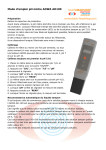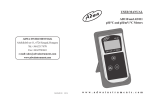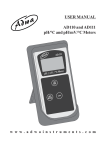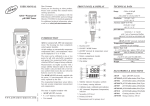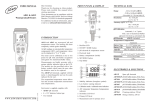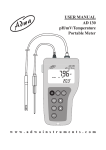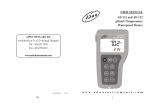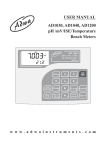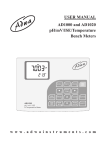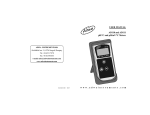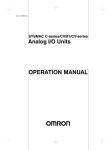Download USER MANUAL AD100 & AD101 pH Testers
Transcript
ERROR MESSAGES USER MANUAL Ec: use a fresh buffer solution. Eb: batteries should be replaced. AD100 & AD101 pH Testers ACCESSORIES AD70004P AD70007P AD70010P ERROR MESSAGES Ec: use a fresh buffer solution. Eb: batteries should be replaced. AD70004P • • • • Microprocessor-based pH tester Automatic temperature compensation Splash-proof keypad Automatic shut-off AD70007P AD70010P pH 4.01 buffer solution 20 ml sachet (25 pcs.) pH 7.01 buffer solution 20 ml sachet (25 pcs.) pH 10.01 buffer solution 20 ml sachet (25 pcs.) www.adwainstruments.com SPECIFICATIONS AD100 Battery Life/Type Dimensions -2.0 to 16.0 pH 0.1 pH ± 0.1 pH Automatic 0 - 50 °C 95 % Relative Humidity 250 Hrs./4x1.5 V 173 x 41 x 22 mm Battery Life/Type Dimensions ISTRAD100 09/14 -2.00 to 16.00 pH 0.01 pH ± 0.02 pH Automatic 0 - 50 °C 95 % Relative Humidity 250 Hrs./4x1.5 V 173 x 41 x 22 mm • • • • Microprocessor-based pH tester Automatic temperature compensation Splash-proof keypad Automatic shut-off www.adwainstruments.com SPECIFICATIONS AD100 Dear Customer, Thank you for choosing an ADWA product. Please read carefully this manual before starting operations. For additional technical information, please e-mail us at: [email protected] Range Resolution Accuracy Temp.compensation Environment Battery Life/Type Dimensions AD101 Range Resolution Accuracy Temp.compensation Environment AD100 & AD101 pH Testers ACCESSORIES pH 4.01 buffer solution 20 ml sachet (25 pcs.) pH 7.01 buffer solution 20 ml sachet (25 pcs.) pH 10.01 buffer solution 20 ml sachet (25 pcs.) Range Resolution Accuracy Temp.compensation Environment USER MANUAL -2.0 to 16.0 pH 0.1 pH ± 0.1 pH Automatic 0 - 50 °C 95 % Relative Humidity 250 Hrs./4x1.5 V 173 x 41 x 22 mm AD101 Range Resolution Accuracy Temp.compensation Environment Battery Life/Type Dimensions ISTRAD100 09/14 -2.00 to 16.00 pH 0.01 pH ± 0.02 pH Automatic 0 - 50 °C 95 % Relative Humidity 250 Hrs./4x1.5 V 173 x 41 x 22 mm Dear Customer, Thank you for choosing an ADWA product. Please read carefully this manual before starting operations. For additional technical information, please e-mail us at: [email protected] CONDITIONING OPERATION CONDITIONING OPERATION Remove the cap. If white crystals have formed, they will be dissolved during conditioning. To condition, soak the tip of the tester in pH 7.01 buffer solution for ten minutes. 1. Remove the protective cap from the bottom of the tester. 2. Press ON/OFF button to turn the tester on. 3. Place the tip of the tester into the sample to be measured. 4. Stir the sample and record the reading when the value has stabilized. The tester will automatically compensate temperature variations. 5. Press ON/OFF button to turn the tester off. Remove the cap. If white crystals have formed, they will be dissolved during conditioning. To condition, soak the tip of the tester in pH 7.01 buffer solution for ten minutes. 1. Remove the protective cap from the bottom of the tester. 2. Press ON/OFF button to turn the tester on. 3. Place the tip of the tester into the sample to be measured. 4. Stir the sample and record the reading when the value has stabilized. The tester will automatically compensate temperature variations. 5. Press ON/OFF button to turn the tester off. CALIBRATION Calibrate your tester once a week or at any time you suspect a problem with the readings. ADWA pH testers can be calibrated at 4, 7 and 10 pH values. ALWAYS CALIBRATE AT pH 7 FIRST. 1. Put the tip of the tester in pH 7.01 buffer solution and press the ON/OFF button. 2. Press CAL button: “7.0” and “pH” will start flashing. When the sign “pH” stops flashing, the reading has stabilized. Then press READ button: “4.0” and “pH” will start flashing. 3. Rinse the tip of the tester with deionized water. 4. Put the tip of the tester in pH 4.01 buffer (for acidic measurements) or in pH 10.01 buffer (for alkaline measurements): “4.0” (or “10.0”) and “pH” will start flashing. 5. When the sign “pH” stops flashing, the reading has stabilized. Press READ. The calibration is completed. ALWAYS USE A FRESH BUFFER SOLUTION FOR CALIBRATION. MAINTENANCE The sensor should be kept moist at all times. This can be done by storing the tester with a few drops of pH 7.01 buffer solution in the protective cap. Rinse the electrode after each measurement with tap water. WARNING: DO NOT USE DEIONIZED OR DISTILLED WATER FOR STORAGE PURPOSES. BATTERY REPLACEMENT When the batteries need to be replaced, the “Eb” error message will appear on the display and the tester will turn off automatically to prevent the unreliable measurement result. Open the battery compartment at the top of the tester. Place the batteries noting the polarity listed in the battery compartment. CALIBRATION Calibrate your tester once a week or at any time you suspect a problem with the readings. ADWA pH testers can be calibrated at 4, 7 and 10 pH values. ALWAYS CALIBRATE AT pH 7 FIRST. 1. Put the tip of the tester in pH 7.01 buffer solution and press the ON/OFF button. 2. Press CAL button: “7.0” and “pH” will start flashing. When the sign “pH” stops flashing, the reading has stabilized. Then press READ button: “4.0” and “pH” will start flashing. 3. Rinse the tip of the tester with deionized water. 4. Put the tip of the tester in pH 4.01 buffer (for acidic measurements) or in pH 10.01 buffer (for alkaline measurements): “4.0” (or “10.0”) and “pH” will start flashing. 5. When the sign “pH” stops flashing, the reading has stabilized. Press READ. The calibration is completed. ALWAYS USE A FRESH BUFFER SOLUTION FOR CALIBRATION. MAINTENANCE The sensor should be kept moist at all times. This can be done by storing the tester with a few drops of pH 7.01 buffer solution in the protective cap. Rinse the electrode after each measurement with tap water. WARNING: DO NOT USE DEIONIZED OR DISTILLED WATER FOR STORAGE PURPOSES. BATTERY REPLACEMENT When the batteries need to be replaced, the “Eb” error message will appear on the display and the tester will turn off automatically to prevent the unreliable measurement result. Open the battery compartment at the top of the tester. Place the batteries noting the polarity listed in the battery compartment.


